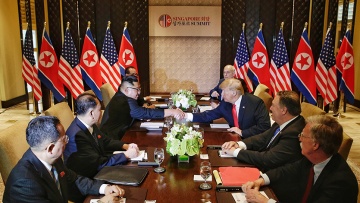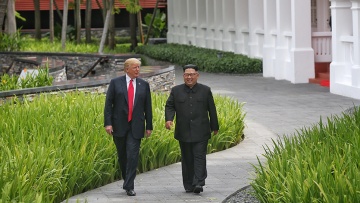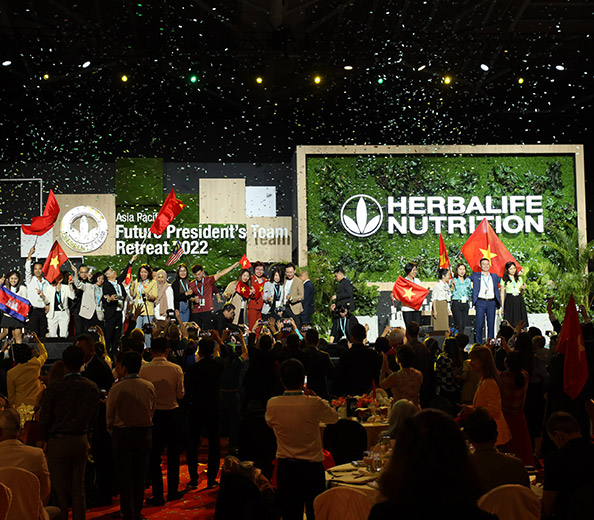Singapore Stands Up to Historic Summit’s Test
Overview
Singapore, a leading tourism and business hub in Asia, is renowned for having hosted some of the most prestigious global events, from large-scale international conventions to regional security summits.
The city-state’s world-class Meetings, Incentives, Conventions and Exhibitions (MICE) capabilities have earned it international accolades as a top business and MICE destination. Singapore has been ranked the top convention city in Asia-Pacific for the past 16 years (ICCA Global Rankings, 2017), and the top meeting city in Asia 11 times (Union of International Associations Global Rankings 2017).
As one of the world’s safest cities, Singapore is also known for its business efficiency, cleanliness and accessibility. It has both excellent infrastructural hardware, including an extensive variety of venues and accommodation options, as well as software, with a skilled and talented tourism workforce capable of organising successful and engaging meetings and events.
Singapore was ranked second in The Economist Safe Cities Index 2017. According to a survey released in early 2016 by global human resources consulting firm Mercer, Singapore is the safest city in Asia, and the eighth safest in the world.
Business as Usual in the Face of Uncertainty
A Strong Track Record of Safety and Security
Ensuring the safety of all parties involved in the Summit was another big priority. Ranked first in the world for Order and Security (World Justice Project (WJP) Rule of Law Index 2017-2018), Singapore has an established track record of hosting regional security summits and high-profile bilateral meetings.
Welcoming the World’s Media
Another unique aspect of the Summit was the hosting of over 2,500 media, the largest-ever media contingent to descend on the Republic. To accommodate such a large and diverse group, the F1 Pit Building, used for the annual FORMULA 1 SINGAPORE GRAND PRIX, was transformed into a three-storey International Media Centre that spanned 23,000 square feet.
With only a limited number of media allowed to attend the Summit in person, some reporters had to rely on live updates of the proceedings. The International Media Centre, which was open around the clock, was equipped with lightning-fast broadband connections and a broadcast centre to ensure that the media received real-time first-hand information of the Summit, which they could then adapt and beam across the world.
This has affirmed Singapore’s position as the top “technology-ready” country in the Asia-Pacific by the World Economic Forum in its Global Information Technology Report 2016.
Warm hospitality was also a critical aspect of this mega media hosting. A diverse and complete food menu comprising 45 dishes across 15 cuisines was prepared for visiting journalists by airport ground handler and food firm Singapore Airport Terminal Services Limited (SATS). The menu included local delicacies that Singapore is famous for, such as laksa (noodles in spicy soup with coconut milk) and chicken rice. All in all, more than 7,000 meals were prepared over the three-and-a-half days.
“The menu was designed to have a good balance between popular local fare – such as Hainanese Chicken Rice and Laksa – and dishes with an international appeal, to showcase Singapore's diverse multi-racial culture,” said Rick Stephen, Director of Kitchens, SATS Ltd. “Despite pressure from the short turnaround, we were able to rise to the challenge because of our culinary and technological expertise, as well as the capabilities of our two Inflight Catering Centres that can produce up to 110,000 meals daily.”
Other homegrown food and beverage companies also came under the spotlight. Old Chang Kee served their signature curry puffs from a food truck, while Ya Kun Kaya Toast dished out local coffee and tea alongside local favourites, such as kaya toast with soft-boiled eggs. Other homegrown brands such as Udders, Sogurt and Sugalight supplied ice cream.
Over four days, media and guests consumed more than 3,500 cups of ice cream, 4,000 cups of coffee and tea, 3,900 slices of toast, 900 hard-boiled eggs, 2,000 pieces of mixed curry puffs and small bites on skewers, and 1,000 boxes of ready-to-eat meals from 24-hour vending machines provided by Chef In Box.
Making the Most of the Singapore Experience
Despite hectic schedules, Singapore’s compact nature and ease of getting around meant that all visitors for the Summit were able to spend time exploring the city’s wealth of leisure experiences, including attractions such as Gardens by the Bay, the Merlion Park, and the SkyPark at Marina Bay Sands®.
Beyond the Summit, some media also found time to visit the Singapore Botanic Gardens, a UNESCO World Heritage site, as well as Punggol housing estate, the latest hallmark of Singapore’s world-class public housing system.
Where Decision Makers Converge, Connect and Collaborate
Mr Nicholas Fang, director of security and global affairs at the Singapore Institute of International Affairs, believes that the Summit has boosted Singapore's branding. This view was echoed by media monitoring firm Isentia, which estimated that 69 per cent of the buzz generated from the Summit was positive.
Social chatter analysed by social media and intelligence company Digimind revealed that the location of the Summit (Singapore and Sentosa) captured about 36 per cent share of voice globally, while media intelligence analyst Meltwater concluded that Singapore may have gained more than $760 million (US$570 million) worth of tourism, retail and media exposure.
While the curtains may have fallen on the historic Summit, it is clear that Singapore’s star continues to rise as a leading business events destination that empowers visitors and enables new possibilities.





